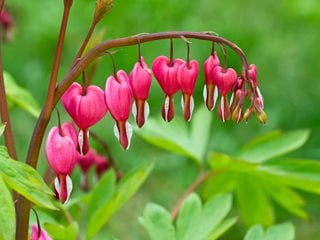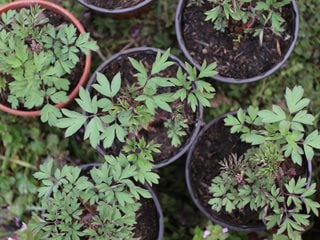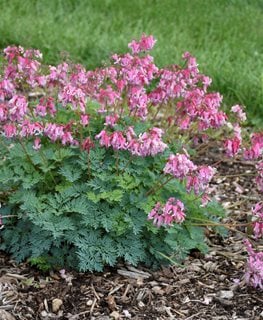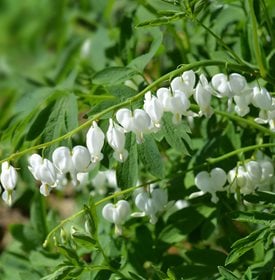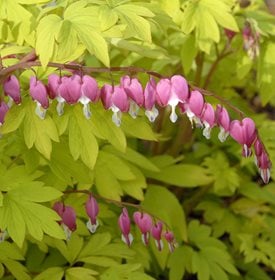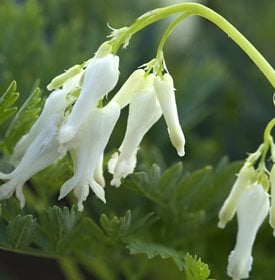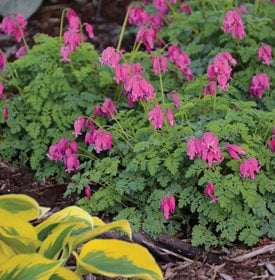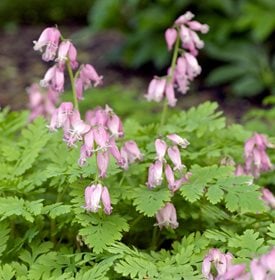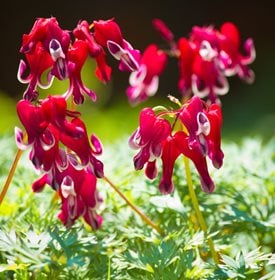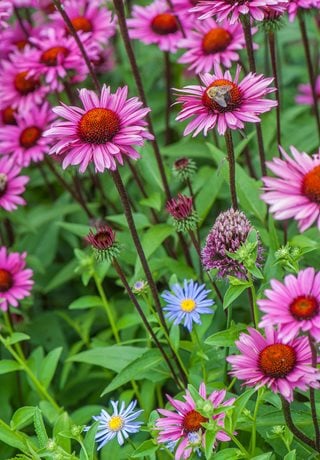GROWING BLEEDING HEARTS
Care & growing information for this low-maintenance plant that loves shadeThese easy-care, shade-loving perennials pop up in early spring and grow quickly. Their characteristic heart-shaped flowers bloom in shades of pink, red or white and hang delicately from arching stems from late spring to early summer.
Common bleeding heart plants (Lamprocapnos spectabilis, formerly Dicentra spectabilis) die back after flowering, but don’t worry — they’ll return again the following spring. Dicentra eximia varieties, also called fringed bleeding hearts, bloom for a longer time and don’t go dormant. Learn more about growing and caring for both of these types of bleeding heart flowers and others.
On this page: Basics | Planting | Care and Maintenance | Pictures | Design Ideas
On this page:
- BLEEDING HEART BASICS
- PLANTING BLEEDING HEART FLOWERS
- BLEEDING HEART CARE TIPS
- BLEEDING HEART PICTURES
- DESIGN IDEAS
BLEEDING HEART BASICS
Zones:
3-9; see specifics on other varieties.
Height/Spread:
Up to 3 feet tall and wide; also compact varieties 1 to 1.5 feet tall & wide.
Exposure:
Partial to full shade, may tolerate sun in cooler northern zones.
Bloom Time:
Common bleeding hearts bloom mid-to-late spring, see specifics on other varieties.
Color:
Varieties bloom in shades of red, pink, white and purple.
Toxicity:
Mild stomach upset can occur if any part of the plant is ingested. Foliage may also aggravate sensitive skin, so care should be taken when handling.
Other:
Bleeding hearts are deer and rabbit resistant.
PLANTING BLEEDING HEART FLOWERS
When to plant:
Plants can be divided or transplanted in the spring or in the fall (after foliage dies back). Plant seeds in the fall; they'll germinate in the spring after a needed chilling period over winter.
Where to plant:
In warmer southern zones, bleeding heart plants should be planted in a shady, cool location. Farther north, they can be located in an area where they will get partial or even full sun if the weather is cool enough. Although they like damp soil, they shouldn’t be planted in an area that can get waterlogged.
How to plant:
Work compost into the soil before planting to provide a humus-rich base. If transplanting bleeding hearts from bare root stock or divided plants, place them with the roots fanned out and pointing down. The ‘eyes’ (where new foliage will grow) should be about an inch below the soil level. If planted too deeply, they may rot or not flower. Water well so the soil will settle in around the roots.
Plant seeds one-half inch deep and keep the soil moist until the first frost. Bleeding hearts will readily self-sow if seed pods are left on the plant and allowed to open.
Spacing:
To allow for their mature size, space them 2 to 2.5 feet apart.
Helpful Hint:
Place markers where your bleeding hearts are planted. Since they die back to ground level and leave no trace once cut back, you’ll want to know where they are so you don’t disturb them when planting summer annuals or fall bulbs.
BLEEDING HEART CARE TIPS
Pruning:
Lamprocapnos spectabilis varieties will die back in the heat of summer, but they’ll be back next spring. Once the foliage has turned yellow and wilted, the plant can be cut back to the ground. It’s important to wait, because up until that time the leaves are busy collecting and storing food and energy for next year. Flower stalks can be deadheaded after blooming to keep your plant looking clean.
Soil:
Bleeding heart plants require moist, fertile, humus-rich soil that is neutral or slightly alkaline.
Amendments & Fertilizer:
Add a time-release fertilizer in the surrounding soil when new growth appears in spring. Additional compost can be added in as well.
Watering:
From spring until winter, water regularly to keep the soil moist but not waterlogged. Bleeding hearts won’t tolerate wet soil over winter or dry soil in summer.
Dividing:
Bleeding heart plants can form large clumps of roots and should be divided about every two to three years. This can be done in the spring just as they begin to grow again or in the early fall when the foliage is cut back. Dig them up carefully and divide with a sharp shovel or garden knife. Replant sections around your own garden or share with friends.
Diseases and Pests:
There are no serious disease or pest problems, although they can be susceptible to aphids. Protect new growth from snails and slugs. Diseases such as downy mildew, Verticillium wilt, rust and fungal leaf spot may occur as well. Bleeding hearts are sensitive to soap-based products, so it’s best to test any pest control products on a few leaves first.
BLEEDING HEART PICTURES
DESIGNING WITH BLEEDING HEARTS
Here are some ideas to help you use bleeding hearts in your garden:
- Perfect choice for Asian or cottage-style gardens.
- Brighten up a dark or shady corner.
- Add spring color under shade trees in woodland gardens.
- Plant smaller growers like ‘King of Hearts’ in rock gardens.
- Combine with other shade-loving perennials that will fill in after bleeding hearts die back, such as hostas, astilbe, monkshood, heart-leaf brunnera, coral bells, and ferns.
- Excellent choice for containers — bring them out in spring to enjoy, move to an out-of-the-way location after the plants die back.
- Use blooming flower stalks in cut-flower arrangements.
Last updated: 6/30/21
RELATED:
Shade Garden Design Ideas
32 Red Flowers for a Gorgeous Garden
30 Pretty Pink Flowers to Grow
25 Perennials for Shade
